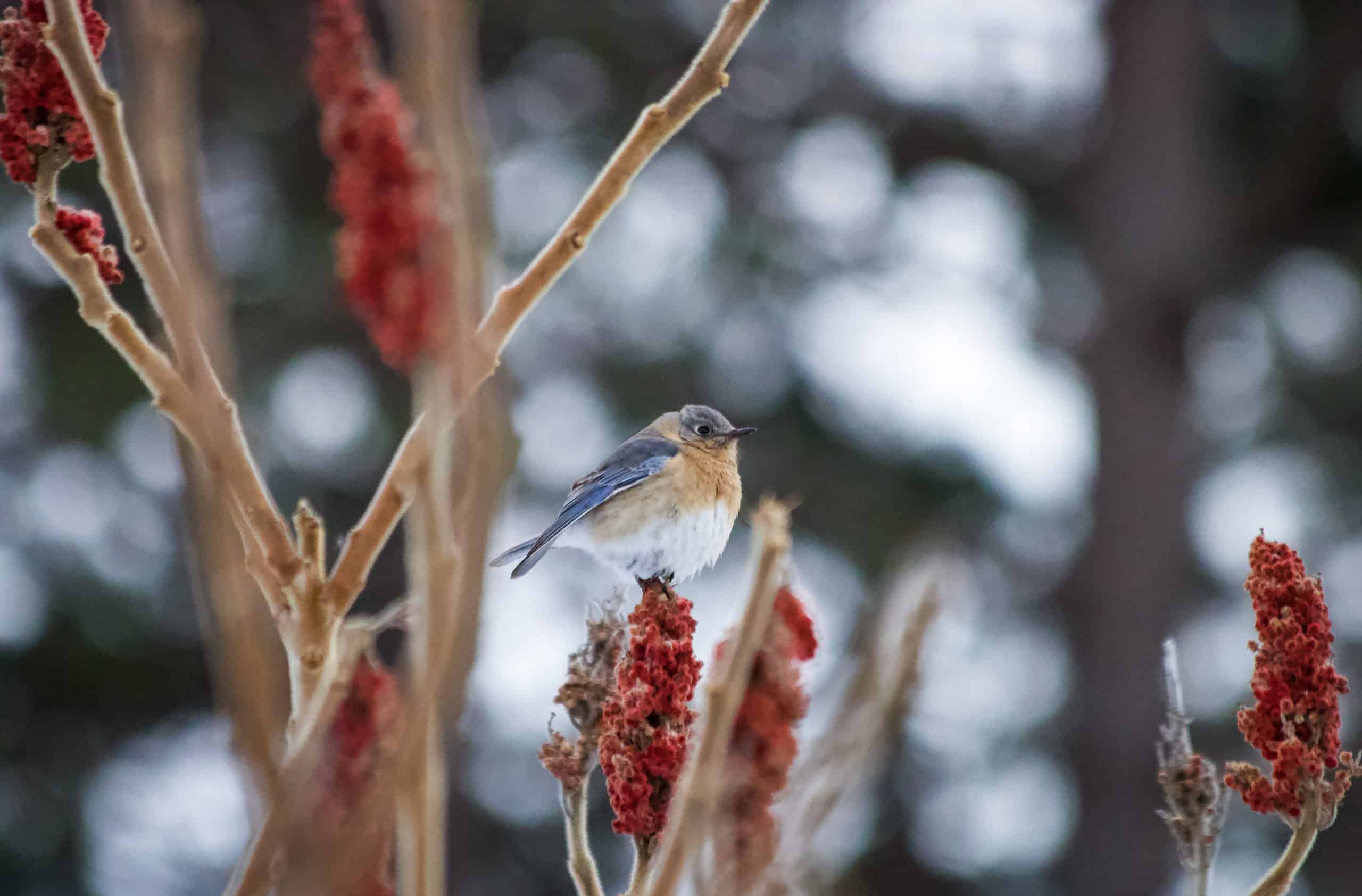Attracting eastern bluebirds to your yard is one of the most exciting aspects of backyard birdwatching. These blue beauties are enticed by a specific habitat, food, and nesting environment. Apply most of these field-tested ways to entice them to your yard and you’re almost guaranteed to have families of eastern bluebirds visit this year.
Just imagine seeing this amazing bird out your window – what a thrill! I wanted this dream too so went straight to the expert backyard birders who regularly attract eastern bluebirds in their yards. Why waste time trying to figure it out on your own? I have all the details for you here.
Here are the 9 field-tested ways to attract eastern bluebirds to your yard:
- Install a bluebird-approved nesting box
- Offer mealworms
- Have water available
- Keep it open
- Provide appealing feeder food
- Plant native
- Avoid clearing dead, dying trees
- Go organic
- Keep kitty inside
Before I get into the detail of these 9 tips I’d like to share where they live, what they look like, their habitat, sounds, diet, mating, and nesting habits.
Where Do Eastern Bluebirds Live?
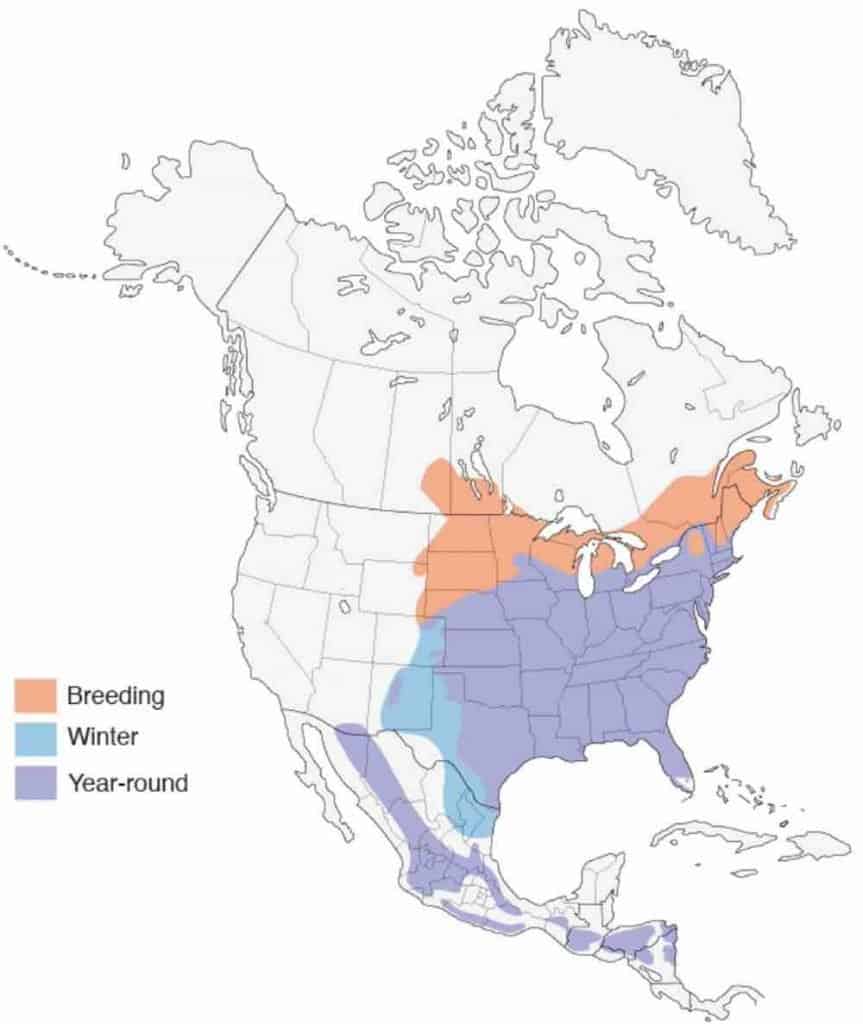
Eastern bluebirds are partial migrators. This means many live year-round in the midwestern, southern, and eastern parts of the US as well as pockets of central Mexico and as far south as Nicaragua while others migrate.
Early to mid-March, the migrating bluebirds head north to the northern midwest states and southern parts of Canada to breed.
In the fall, the migrators take a short trip to Texas, New Mexico, and far northern parts of Mexico for the winter.
What do Eastern Bluebirds Look Like?
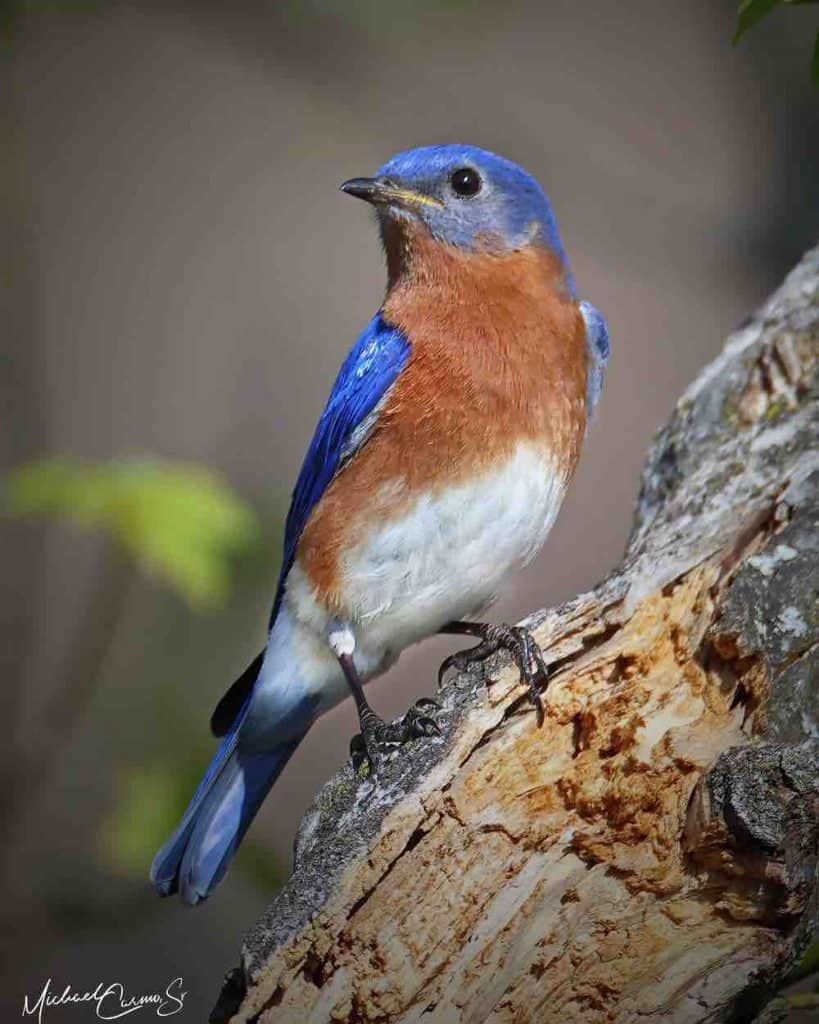
The male eastern bluebird is a small bird, about 7″ long, with a brilliant royal blue head, wing & tail, and short legs. An orange-rust color paints their throat and breast, while their belly and undertail are white.
Females are nearly the same except colors are a bit more muted.
Juvenile eastern bluebirds also have blue wings but wings are spotted with dark grayish brown on the breast and back.
During the winter, bluebirds take on a duller appearance.
A member of the thrush family, the closest relative is the western bluebird.
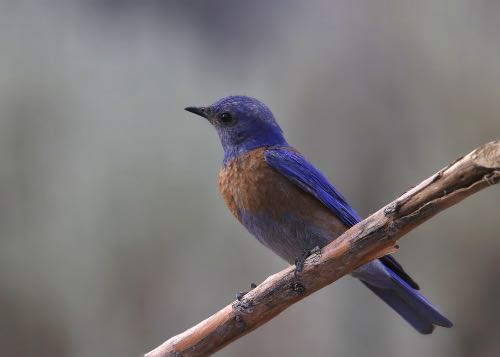
Western bluebirds are the same size but trade the brilliant royal blue for a deeper shade of blue and more orange than rust-orange. The western bluebird range narrowly overlaps with that of the eastern bluebird so it’s unlikely you’ll see them both.
Habitat
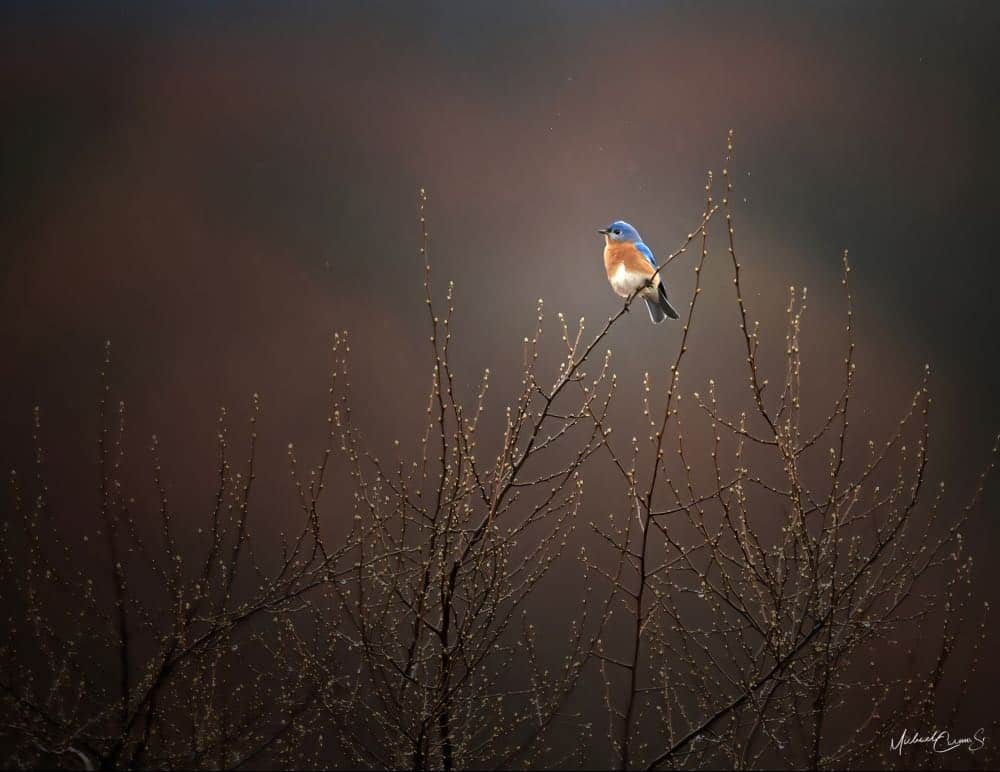
Wide-open spaces. That’s where eastern bluebirds thrive. Open prairies, grasslands, fields, and meadows are ideal areas to find them. In fact, golf courses are notorious for attracting this blue beauty.
If they can find a low place to perch like a fence or power line while scanning for food, even better.
It’s also common to find them in patchy wooded areas and suburbs where wide-open lawns offer ideal nesting spots.
Eastern bluebirds are common these days but it wasn’t always that way. Their population dropped off significantly in the early to mid-1900s due to a proliferation of non-native birds aggressively taking over nesting sites as well as the erosion of their natural habitat.
During the 1800s the house sparrow and European starling were brought to the US. These birds reproduced exponentially and now outnumber many of our native birds.
It wouldn’t be so bad except the house sparrow and European starling compete for the same nesting cavities and are bullies & murderers to our native birds – in particular the eastern bluebird.
Conservationists and backyard birders alike heard the rallying cry and during the 1960s and 1970s joined the movement to put up nesting boxes in masses. As a result, the eastern bluebird has made an amazing comeback.
This is great news of course but they still need our help if they are to thrive since the non-natives are a continual threat to the adult and bluebird babies.
Even today, it’s not uncommon for backyard birders to open their nesting box only to see the crushed, mutilated remains of mama bluebird and her babies at the hand of a non-native. This is why it’s crucial to understand the best nesting box design for bluebirds as they are less desirable to non-natives. More on that later.
What do Eastern Bluebirds eat?
Bluebirds thrive on insects and spiders during spring and summer including crickets, grasshoppers, beetles, earthworms, and snails. There have even been a rare sighting of a bluebird dining on small lizards or tree frogs
They like to perch in a low, open spot (think rural fence) and hop down when they spot a tasty bug to devour. They’ve also been known to catch an insect while flying. Reportedly they can spot an insect more than 60 feet away.
In late fall and winter, their diet consists of small fruits. Fruit-bearing trees, shrubs, and vines are crucial to their survival during this time.
As you’ll soon learn, bluebirds will also feed on some birdseed mixes and suet.
What do Eastern Bluebirds Sound Like?
Eastern Bluebird Song
Bluebirds have the sweetest little bird song. It’s short – a few seconds at most and sung from a high perch or even while in flight. Take a listen:
Eastern Bluebird Call
The male bluebirds’ call is very short and subtle. The female’s call is similar but a bit shorter. Pairs will also use this sound when approaching the nest to feed their young. Take a listen:
Mating, Nesting, Eggs & Fledglings
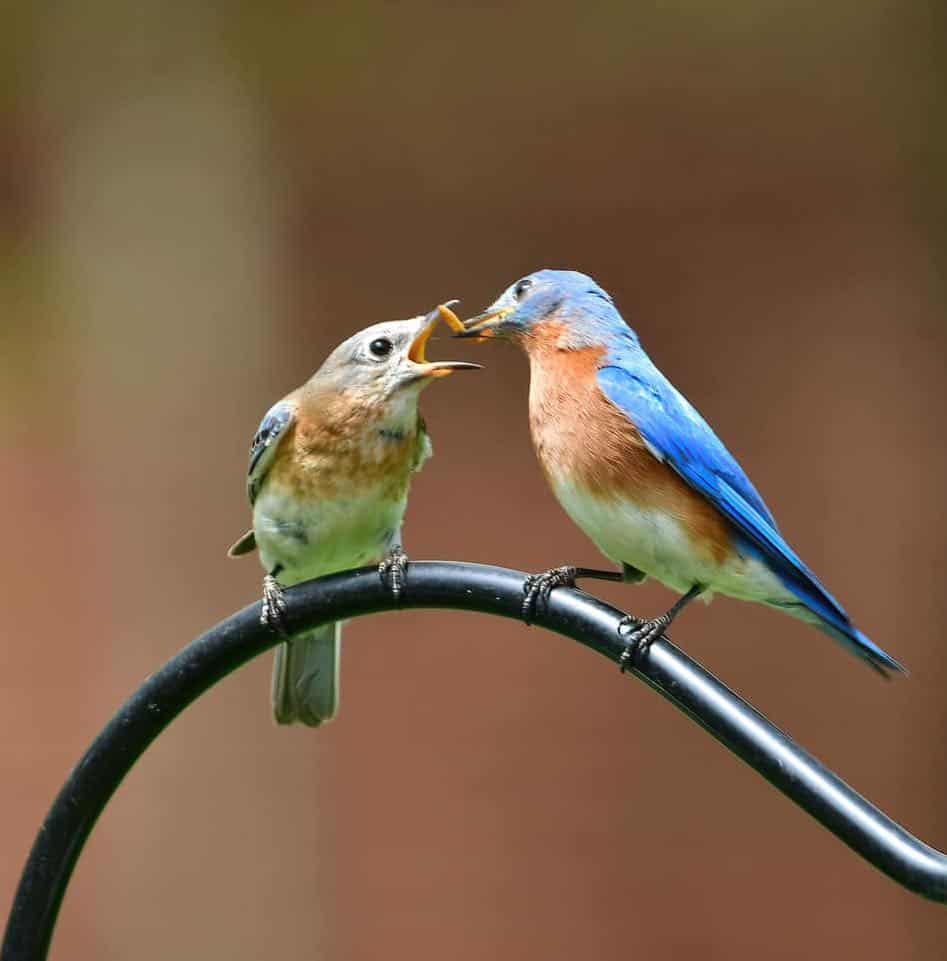
Male bluebirds court the female by perching on their nest site and waving their wings as well as transporting nesting material in and out of the nest site.
This waving of feathers course highlights the male’s beautiful blue colors in hopes of impressing and attracting a mate. Females will sometimes return the gesture when they are together.
Check out this video of a “studly” male eastern bluebird shaking his thing.
Bluebirds are cavity nesters. A former woodpecker hole found in dead or dying tall (up to 20′) trees are ideal but bluebirds also favor man-made nesting boxes – especially the older bluebirds.
Tree cavities and nesting boxes are limited so many birds will battle to secure one – bluebirds are no different. In fact, they’ve been known to attack some of their biggest threats – House Sparrows and European Starlings – as well as other birds to defend their home.
They will commonly switch to an alternate nest (natural cavity vs. nestbox) for future broods.
According to The Cornell Lab, bluebirds seemed to prefer snugger nest boxes (4 inches square instead of 6 inches square on the bottom).
The male will fill the cavity with weeds, twigs, grasses, pine needles, and even animal fur or feathers while the female actually builds the nest in preparation for laying eggs and raising the young.
It’s not uncommon for bluebirds to build nests in multiple nest sites, but they generally only use one of them.
Bluebird pairs often raise multiple sets of babies in the same nest site as they can have anywhere from one to three broods in a season.
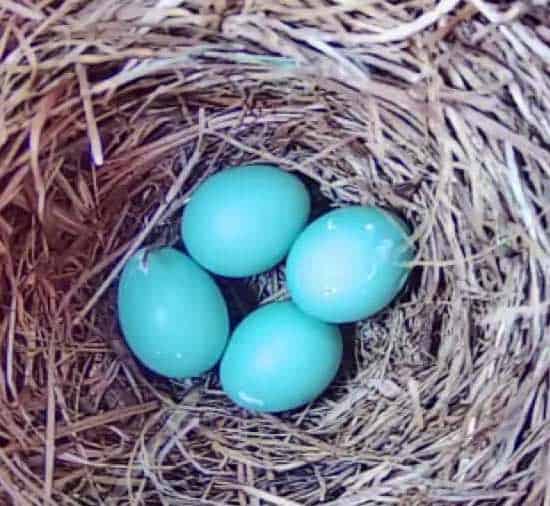
The female will typically lay between four and five eggs. Bluebird eggs are about .7 – .9″ long, pale blue (sometimes but rarely white).
The female will incubate them for about 11-19 days after which both parents will bring food to the babies. According to audubon.org, in some cases even young from a previous brood will help to feed the young.
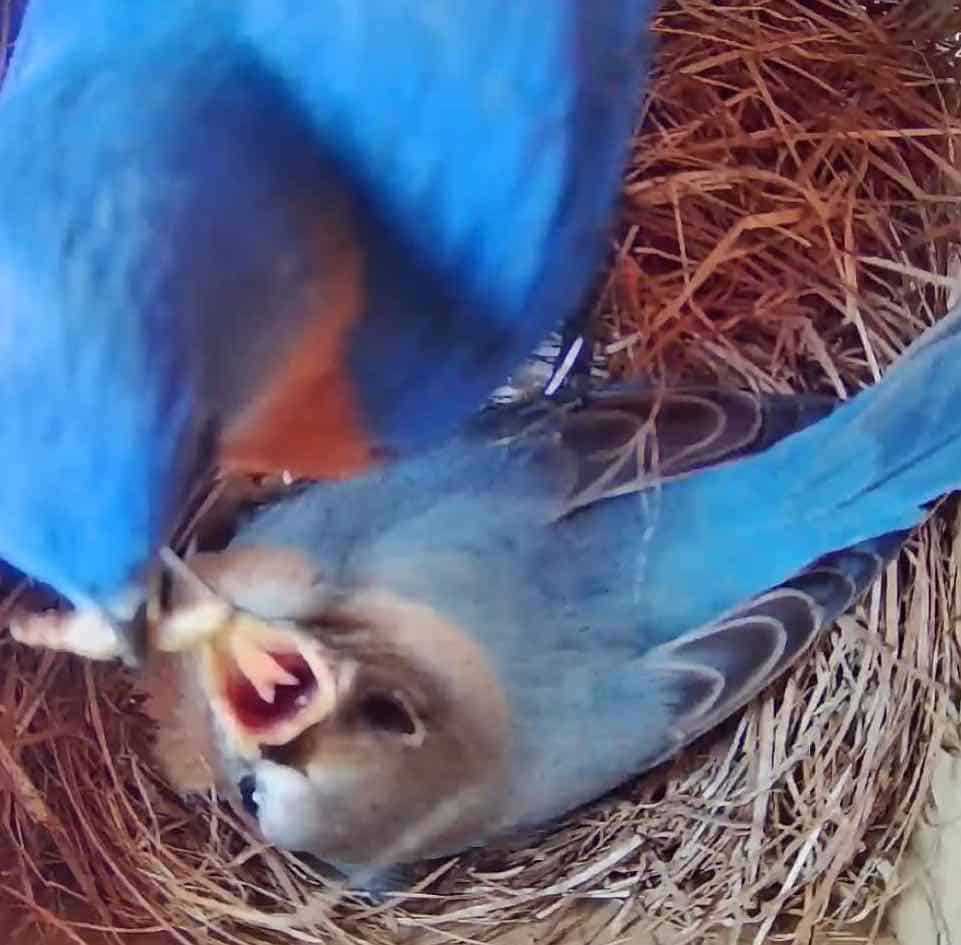
After about 19 days the fledgling will leave the nest.
Predators
Bluebirds and their young have many predators including but not limited to: hawks, owls, raccoons, snakes, flying chipmunks, flying squirrels, black bears, and house cats. Truly, the list goes on.
As mentioned, house sparrows and European starlings are also a threat to bluebirds. Not only do they outright attack and decimate them and eat their young, but they also favor the same nesting sites as bluebirds so reducing opportunities for the bluebird to find a suitable place to raise their family.
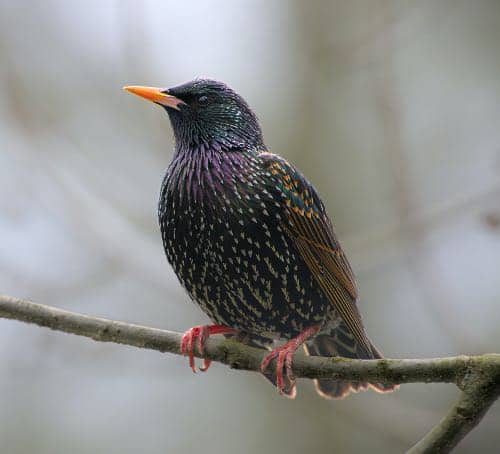
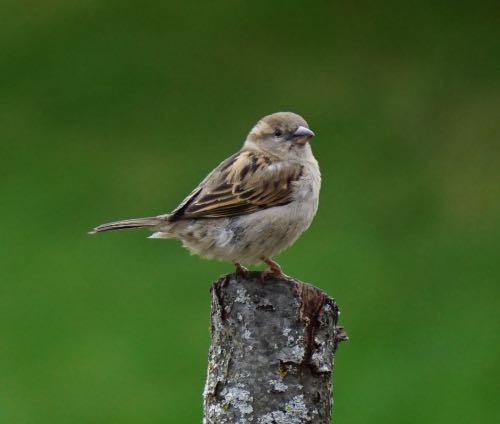
9 Ways to Attract Eastern Bluebirds to Your Yard
If you live within the range of eastern bluebirds you have a good chance of spotting one as they are fairly common. They’re more likely to visit your yard if it offers elements of their natural habitat and food preferences.
This bird is relatively social so if you see one you’re almost certain to see two (a pair) and even more. To follow are nine field-tested ways to increase your chances of hosting eastern bluebirds in your yard.
1. Install a bluebird-approved nesting box
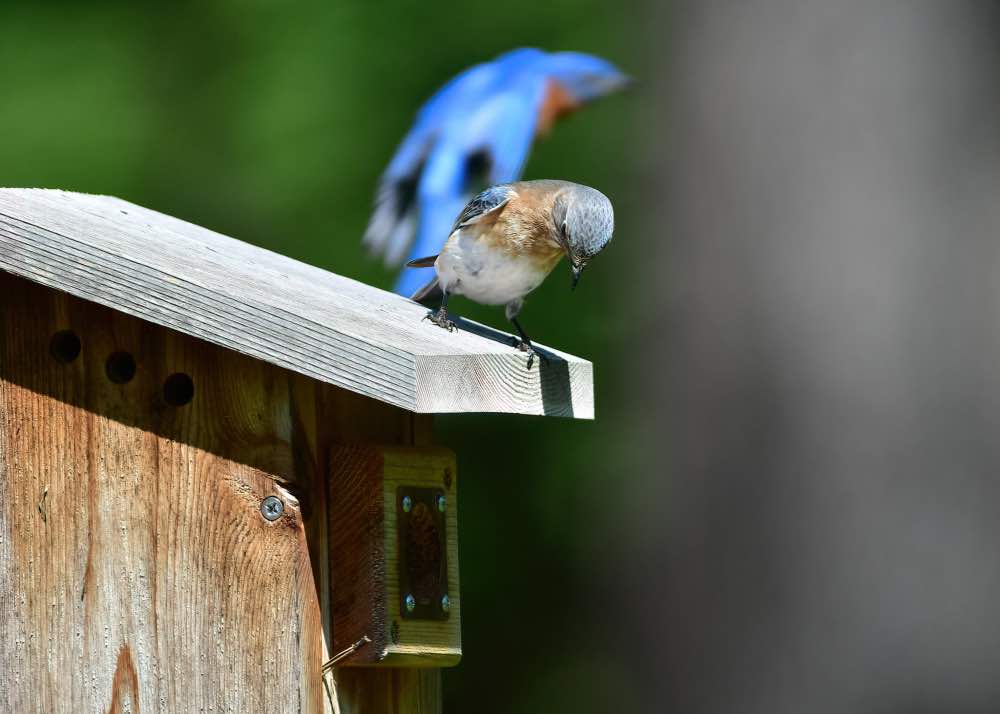
Bluebirds are cavity nesters meaning they build their nest inside a hole – a drilled-out tree hole left by woodpeckers or a manmade nesting box.
Many other birds are also cavity nesters resulting in a very competitive hunt for nesting sites. Many other birds are bigger, bullier, and/or meaner than bluebirds which leaves them at a disadvantage.
Back in the 1960s when the bluebird population was dwindling dramatically, in part due to fewer nesting sites available, an entire industry was born dedicated to making bluebird nesting boxes. Today you can buy premade bluebird nesting boxes and will have a large selection to choose from.
It’s important to purchase or build a nest box specifically for bluebirds as they are different.
Bluebird nesting box requirements:
- Should be made from cedar or redwood for longer wear;
- Should not be painted or stained to avoid toxicity – especially inside the box;
- The roof overhang should be close to the entry hole, so water can’t enter the box.
- Air holds at the top and drainage holes at the bottom.
- The entry hole should be round and 9/16″ in diameter to prevent large bully birds like European starlings from entering.
- There should NOT be a perch since bluebirds won’t use it but bully birds like House Sparrows will.
- Cavity size should not be larger than 4″x4″ (or 4″x5″ maximum) as bluebirds prefer the cozier size.
- Floor to entrance hold should be 5-6″.
- Easy access door to remove old nesting material but secure enough that animals cannot enter.
Bonus Tips
- Install the nest box 4-6 off the ground on a post or pole and position it to the east toward the open habitat area and away from the elements.
- Attach guards to deter nest-raiding predators.
- Monitor the nest so you know when the fledglings have left. Then clean out the box right away so it can be used for another pair or subsequent broods.
- To deter house sparrows, many have had success installing screws to the 4 corners of the roof and winding fishing lines from corner to corner and diagonally. No one truly knows why it works but many have reported success with this tip.
Did you know? It’s illegal to disturb the nest of a native bird. House sparrows and European starlings are non-native birds so the law doesn’t apply to them. In fact, some organizations encourage the removal and destruction of these birds.
2. Offer mealworms
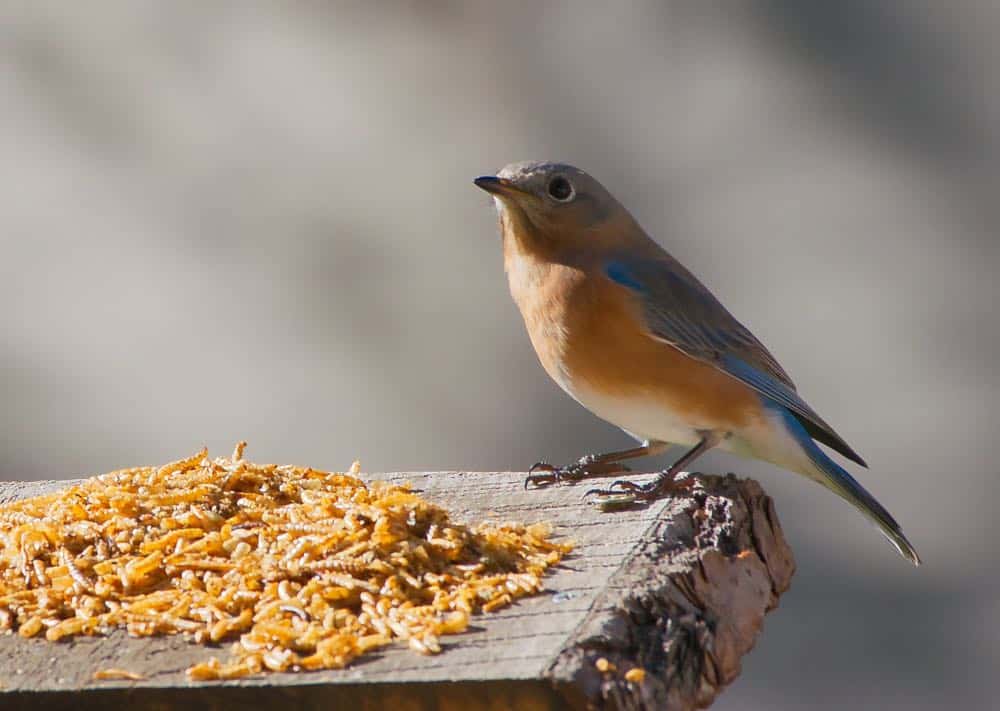
Mealworms are actually the larvae of the mealworm beetle and since bluebirds’ primary source of food is insects, mealworms are the ideal natural food to offer them.
Live mealworms are commonly available at your local nature store and dehydrated varieties are available online as well as at the local nature store.
Dehydrated mealworms last longer, require no maintenance, and are cheaper but sometimes takes bluebirds longer to realize they are actually food, delaying their visit to your yard.
Pro tip: Offer 1/2 dozen live, wiggly mealworms at first to catch the bluebird’s eye more easily. Then, slowly transition to a mix of live and dehydrated mealworms until you are offering exclusively dehydrated.
Mealworms can be placed in a dish for the birds – just make sure the dish has sides when offering live ones otherwise they’ll climb out and escape!
3. Have water available
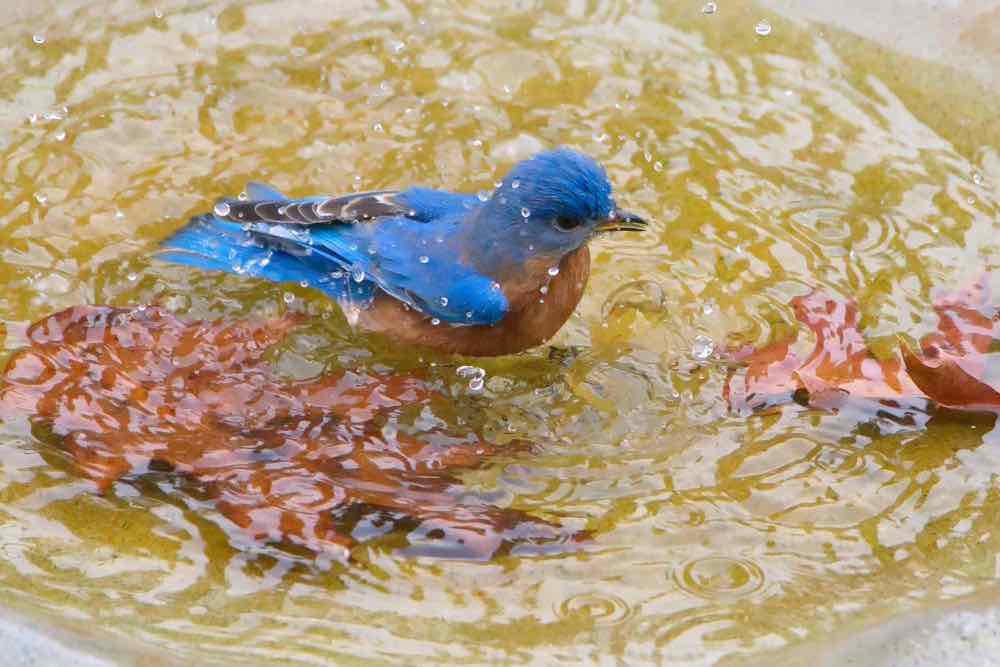
All birds need water to drink and bathe in. Bluebirds are no different. If a natural source of water is not available nearby consider installing a pond – even a small patio pond will attract all wild birds.
A birdbath is another viable option. Birds are drawn to moving water so adding a fountain to the birdbath could increase your chances of attracting one. Bluebirds are relatively small so make sure the birdbath does not exceed 1/2 in-depth or add layers of flat rocks as an alternative.
4. Keep it Open
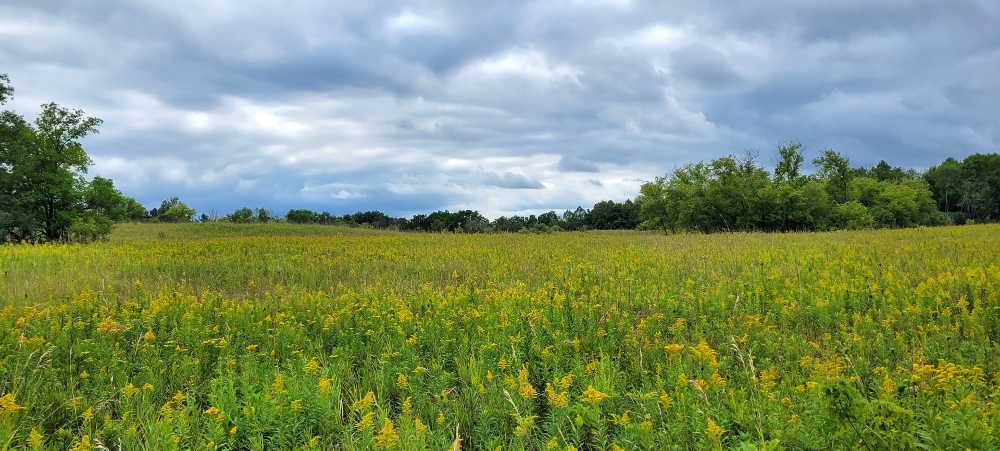
If you have a wide expansive yard or a large portion of it is expansive, you’re in luck. Eastern bluebirds thrive in open areas – prairies, meadows, and even golf courses have been known to attract many a bluebird.
If not, and if you’re willing, perhaps you can clear an area of your yard to mimic a prairie-type ambiance where grass can grow longer.
6. Plant native
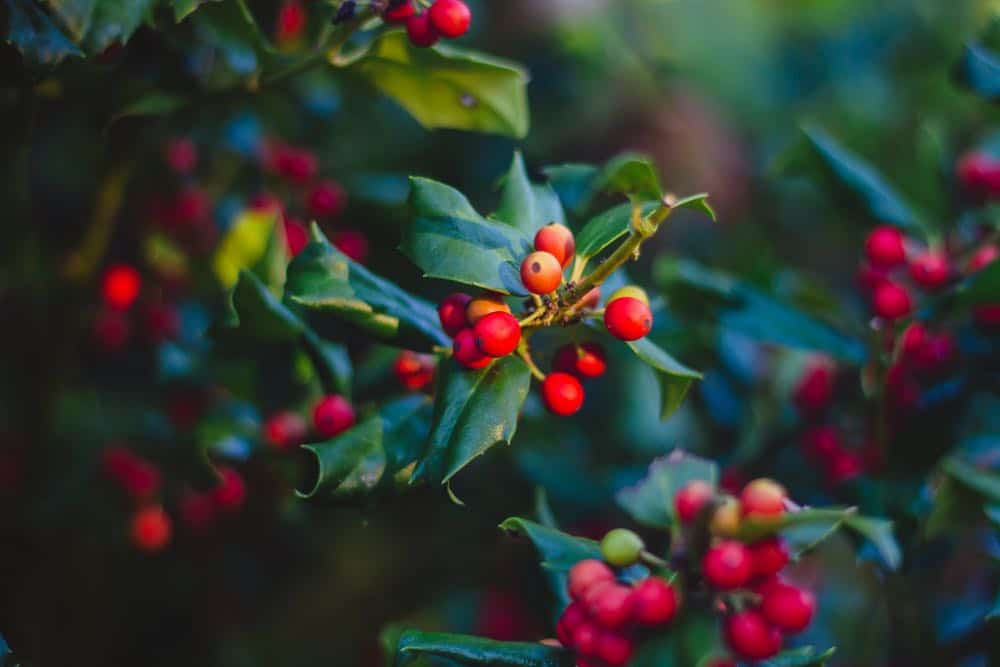
During the fall, winter, and early spring when insects are scarce, bluebirds rely on the fruit from trees, shrubs, and vines for substance.
Trees and shrubs also provide protection from predators such as hawks.
Native plants are particularly ideal because they don’t require special treatment to thrive and produce fruit. Non-native plants often require toxic fertilizers and pesticides which can kill birds.
According to the Michigan Bluebird Society, below are some native trees, shrubs, and vines you can include in your yard that attract bluebirds.
Trees
- American Holly
- Black Cherry
- Cascara Buckthorn
- Mountain Ash
- Dogwood – Silky, Flowering, Gray, Red Osier, Alt. Leaf
- Pin Cherry
- Red Mulberry
- White Mulberry
- Serviceberry
- Flowering Dogwood
- Hackberry
- Hawthorns
- Madrone
- Mountain Ash
- Red Cedar
- Sour Gum
- Eastern Red Cedar
- Spruces
- Evergreens
- Pines
Shrubs
- Blackberry
- Raspberry
- Chokeberry
- Chokecherry
- Dogwood shrubs
- Elderberry
- Shadbush
- Snowberry
- Viburnums
- Bayberry
- Blackhaw
- Cotoneaster
- Highbush Cranberry
- Holly
- Mistletoe
- Sumac
- Highbush blueberry
- Nannyberry
- Winterberry
Vines
- Grape
- Greenbriar
- Pyracantha
- Virginia Creeper
5. Provide Appealing feeder Food
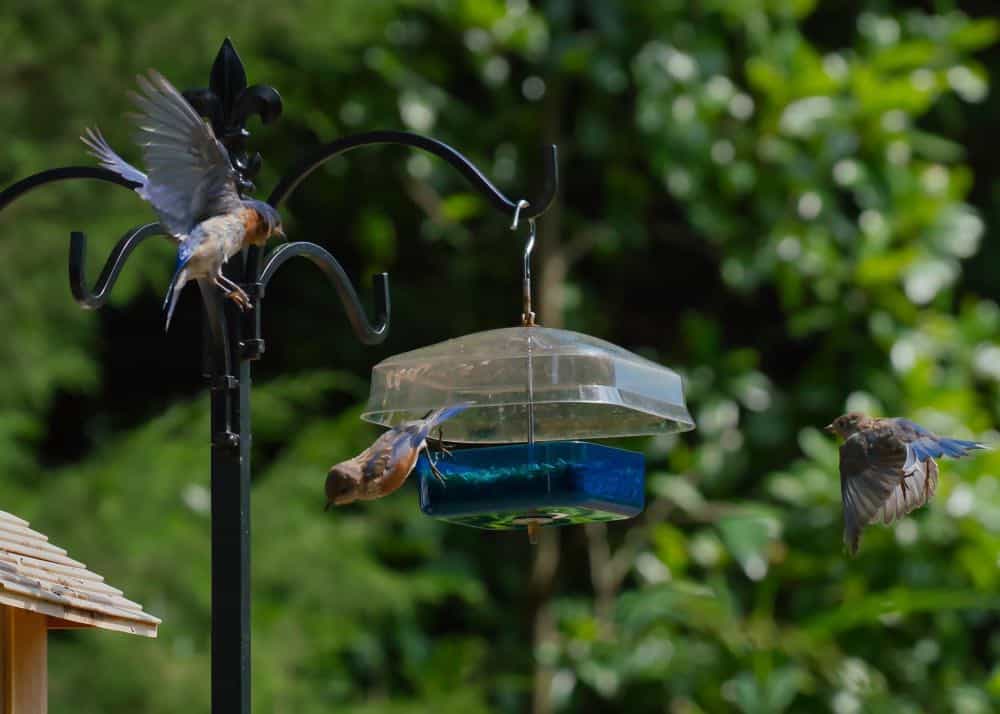
As mentioned before, offering mealworms immediately raises your chances of attracting bluebirds.
After mealworms, many have had success getting bluebirds to their feeder by offering the following food – especially in early spring, fall and winter when insects aren’t available.
- Suet
- Peanut butter spread
- sunflower seeds
- jelly
- dried fruit (raisins, currants, grapes)
And no, your feeder does not need to be blue to attract a bluebird!
7. Avoid clearing dead, dying trees
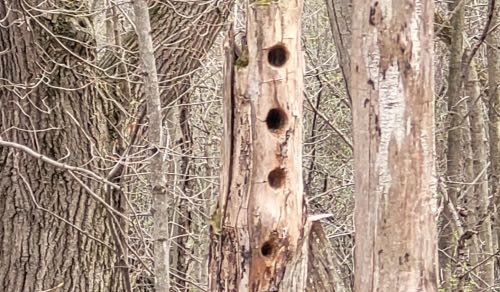
Standing trees with holes excavated and abandoned by woodpeckers are ideal for bluebirds to nest in. If you’re serious about attracting them to your yard, resist the urge to knock down and haul away these trees.
8. Go organic
Avoid using chemicals in and around your yards such as grass fertilizer and pesticides. Bluebirds, and other wild birds, consume insects as their primary source of food and if you kill them off, there won’t be any to eat.
Equally horrible would be death by poisoning in the case of a wild bird eating a toxic insect!
9. Keep kitty inside

A primary predator of birds everywhere is cats – house cats. This includes feral cats that can roam a neighborhood.
According to a study published in Nature Communications, each year almost 4 billion wild birds lose their lives to outdoor cats. Not only does this rock the ecology it makes your yard unappealing and dangerous for many forms of wildlife.
If it’s your cat, keep it inside. Don’t be fooled. Even the nicest and sweetest of kitties have the natural instinct to hunt birds. It’s not their fault.
If it’s a feral cat implement a non-toxic deterrent method such as scattered fresh orange or lemon peels in the area.
If you’re really gung ho, consider trapping the feral feline and taking it to a human society that offers free neutering/spaying. This may prevent the next person from having to deal with a feral cat at their feeder.
Next Steps
I think you’ll agree bluebirds are worth the effort to attract to your yard. Take and apply some of the tips I provided or if you’re really serious about attracting them to your yard – apply all of them! Good luck and happy birding!
Frequently Asked Questions
Do bluebirds come back to the same nest every year?
Eastern bluebirds can have up to three sets of broods each season and commonly use the same nesting site. This is more typical for non-migrating bluebirds. For those that do migrate, it’s unlikely they’ll nest in the same site.
Where do bluebirds live in Winter?
Eastern bluebirds are partial migrators. Some of them do not migrate. Instead, they live year-round in the midwestern, southern, and eastern parts of the US. Other bluebirds will travel south to Texas and New Mexico for the winter.
How can I attract more bluebirds?
Once you’ve mastered the basics and have one or two eastern bluebirds coming to your yard you can implement an advanced tactic – “bluebird trails”. This approach entails installing multiple bluebird nest boxes spaced about 300′ apart over a stretch of open space. This is effective because eastern bluebirds depend on cavities to raise their family and naturally made ones are in limited supply.

